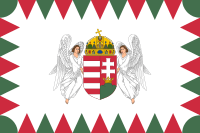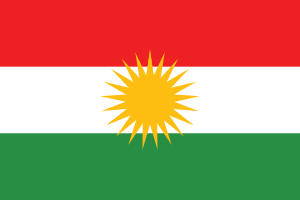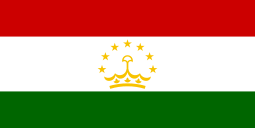Flag of Hungary
 | |
| Use | Civil and state flag |
|---|---|
| Proportion | 1:2 |
| Adopted | October 1, 1957 |
| Design |
A horizontal triband of red, white and green The official Hungarian state flag does not contain the Hungarian coat of arms, but the coat of arms is often used during solemn occasions. |
|
Variant flag of Hungary | |
| Use | Civil flag and ensign |
| Proportion | 2:3 |
| Adopted | October 1, 1957 |
| Design | A horizontal tricolour of red, white, and green |
|
Variant flag of Hungary | |
| Use | War flag |
| Proportion | 3:4 |
| Adopted | 1950 |
|
Variant flag of Hungary | |
| Use | Naval ensign |
| Proportion | 3:4 |
| Adopted | 1946 |
The flag of Hungary (Hungarian: Magyarország zászlója) is a horizontal tricolour of red, white and green. In this exact form, it has been the official flag of Hungary since October 1, 1957. The flag's form originates from national republican movements of the 18th and 19th centuries, while its colours are from the Middle Ages. It both shares close relations to the flag of Bulgaria.
Current flag
The nation of Hungary originated from the national freedom movement from before 1848, which culminated in the Hungarian Revolution of 1848. The revolution was not only in opposition against the monarchy but also the Habsburg Empire, as well as to form an independent republic. Accordingly, the Hungarian flag features a tricolour element, which is based upon the French flag, as a reflection of the ideas of the French revolution; while red, white, and green are colours derived from the historical Hungarian coat of arms, which have essentially remained in the same form since the mid-15th century, with exception to some minor differences, and were marshalled from arms that first appeared in the late 12th and early 13th century as arms of the Árpáds, Hungary's founding dynasty. The stripes are horizontal rather than vertical to prevent confusion with the Italian flag, which had also been designed after the French flag. According to other data, the recent form of the Hungarian tricolour had been already used from 1608 at the coronation of Mathias II of Hungary.
Folklore of the romantic period attributed the colours to virtues: red for strength, white for faithfulness and green for hope. Alternatively, red for the blood spilled for the fatherland, white for freedom and green for the land, for the pastures of Hungary. The new constitution, which took effect on 1 January 2012, makes the ex-post interpretation mentioned first official (in the semi-official translation: strength (erő), fidelity (hűség) and hope (remény)).
Evolution
As described above, the red-white-green tricolour emerged as a sign of national sovereignty during the 1848–1849 revolution against the Habsburgs. After the revolution was defeated, the tricolour flag was prohibited by the Austrian Emperor; after the Compromise of 1867, however, the tricolour became not only legal, but also the official flag of Hungary. The flag had the so-called minor arms (also known as the Kossuth coat of arms) of Hungary with archangels as supporters were used as a badge on the flag. This configuration was used until the end of the Habsburg Empire in 1918.
After the fall of the Habsburg Empire, the years 1918 to 1920 were highly turbulent, and several hard-to-trace minor changes took place. The red-green-white tricolour stayed the same, but small differences emerged in terms of the badge. A short interlude and exception was the 1919 Hungarian Soviet Republic, which lasted for four-and-a-half months; it used a solid red banner.
It seems that from 1920–1944 or 1945 the tricolour displayed the minor arms of Hungary, but the version without them was also used.
Between 1946 and 1949 the crown was removed from the top of the arms serving as the badge.
With the onset of Communist rule in 1949, a new coat of arms featuring a Communist red star was placed on the flag as the badge.
During the anti-Soviet uprising in 1956, revolutionaries cut out the Stalinist emblem and used the resulting tricolour with a hole in the middle as the symbol of the revolution. For some months the new government changed the flag to bear the minor arms without the crown as the badge again.
In 1957, during the Stalinist restoration after the revolution was defeated by the Soviet Red Army, the new government created a "new" coat of arms, which however was never officially put onto the flag. Therefore, the official flag of Hungary has been a pure red-white-green tricolour since 1957.
After the fall of communism in 1989 there was no need to change the flag, as it did not bear any communist insignia.
There was a recommendation of the Committee of Symbols some years ago, that the coat of arms should be part of the state flag, while the national flag should remain plain (as is the status quo). This has not been implemented in law, though in case of most state use the arms are legally permitted on the flag (see below).
Exact description and legislature
The Hungarian Constitution does not explicitly state anything about the width:length ratio of the flag;[1][2][3] but, there is a law from 1957 that is in force stating that seagoing merchant vessels shall hoist the red–white–green tricolour in 2:3 ratio.
By a government decree from 2000, the ratio (which is neither defined in the Constitution nor in 1995[4] or 2000[5] legislation) of flags used on government building is 1:2.
Summarized, this would mean:[4]
-
 A red–white–green tricolour. Actually many variations might be used though according to 1995/LXXXIII §11 (3) "(3) In cases specified in paragraphs (1) and (2), the arms and the flag can be used also in their historical forms.", as (1) reads as: 1995/LXXXIII §11 (1) "(1) For the purpose of declaring their belonging to the nation, private persons can use the arms and the flag, subject to the limitations in this law."
A red–white–green tricolour. Actually many variations might be used though according to 1995/LXXXIII §11 (3) "(3) In cases specified in paragraphs (1) and (2), the arms and the flag can be used also in their historical forms.", as (1) reads as: 1995/LXXXIII §11 (1) "(1) For the purpose of declaring their belonging to the nation, private persons can use the arms and the flag, subject to the limitations in this law." -
 red–white–green tricolour, ratio 1:2 (by decree from 2000). According to 1995/LXXXIII §11 (4), the official coat of arms of Hungary might be placed onto it as a badge.
red–white–green tricolour, ratio 1:2 (by decree from 2000). According to 1995/LXXXIII §11 (4), the official coat of arms of Hungary might be placed onto it as a badge. -
 White background with green red alternated flammulette ("flame tongues", triangles with wavy edge) border, coat of arms in the center, embraced by oak branches from the left, olive branches from the right. Ratio not defined. ( 1995/LXXXIII §8 (1) )
White background with green red alternated flammulette ("flame tongues", triangles with wavy edge) border, coat of arms in the center, embraced by oak branches from the left, olive branches from the right. Ratio not defined. ( 1995/LXXXIII §8 (1) ) -
 2:3 (ratio defined by 1957 law) red-white-green tricolour (there is a merchant fleet)[6]
2:3 (ratio defined by 1957 law) red-white-green tricolour (there is a merchant fleet)[6] -
 Unknown or unspecified;
Unknown or unspecified; -
 White background with green red alternated triangle border, coat of arms at 1/3 of the flag, nearer to the pole. Ratio not defined. ( 1995/LXXXIII §8 (2) )
White background with green red alternated triangle border, coat of arms at 1/3 of the flag, nearer to the pole. Ratio not defined. ( 1995/LXXXIII §8 (2) )
Gallery
.svg.png) Flag of the Árpád dynasty and the Principality of Hungary from 895-1000.
Flag of the Árpád dynasty and the Principality of Hungary from 895-1000. Alternate flag.
Alternate flag..svg.png) Flag of the Kingdom of Hungary under the rule of Stephen I. The flag was used again from 1382-1867.
Flag of the Kingdom of Hungary under the rule of Stephen I. The flag was used again from 1382-1867..svg.png) Flag of the Kingdom of Hungary under the Angevin dynasty from 1301-1382.
Flag of the Kingdom of Hungary under the Angevin dynasty from 1301-1382..svg.png) Flag of Hungary, used between 1867–1918, while part of Austria-Hungary.
Flag of Hungary, used between 1867–1918, while part of Austria-Hungary..svg.png) Flag of the short-lived Hungarian Democratic Republic from 1918–1919 under the rule of Károlyi.
Flag of the short-lived Hungarian Democratic Republic from 1918–1919 under the rule of Károlyi. Flag of the Hungarian Soviet Republic, used briefly in 1919.
Flag of the Hungarian Soviet Republic, used briefly in 1919..svg.png) Flag of Hungary, used between 1920–1946 with the Hungarian coat of arms.
Flag of Hungary, used between 1920–1946 with the Hungarian coat of arms..svg.png) Flag of Hungary, used between 1946–1949 and 1956–1957 with the Kossuth coat of arms.
Flag of Hungary, used between 1946–1949 and 1956–1957 with the Kossuth coat of arms..svg.png) Flag of Hungary, used between 1949–1956, bearing the Communist Rákosi coat of arms.
Flag of Hungary, used between 1949–1956, bearing the Communist Rákosi coat of arms..svg.png) This flag, from which the Rákosi era coat of arms has been cut out, became the symbol of the Hungarian Revolution of 1956.
This flag, from which the Rákosi era coat of arms has been cut out, became the symbol of the Hungarian Revolution of 1956. Flag of Hungary, used from 1957.
Flag of Hungary, used from 1957..svg.png) Flag of Hungary, used between 1957-1989 (unofficial).
Flag of Hungary, used between 1957-1989 (unofficial)..svg.png) Standard of the Regent, used between 1920–1944.
Standard of the Regent, used between 1920–1944..svg.png) Standard of the President, used between 1948–1950.
Standard of the President, used between 1948–1950..svg.png) Standard of the President, used between 1990-2012.
Standard of the President, used between 1990-2012. Standard of the President
Standard of the President
Similar flags
|
See also
References
- ↑ The Fundamental Law of Hungary
- ↑ Magyarország Alaptörvénye
- ↑ The Constitution of the Hungarian Republic
- 1 2 Law 1995/LXXXIII
- ↑ Law 2000/XXXVIII
- ↑ Volker Preuß. "Flagge Ungarns" (in German). Retrieved 2002-12-10.
External links
| Wikimedia Commons has media related to Flags of Hungary. |
- Hungary at Flags of the World
- Flag of Hungary at www.rbvex.it












.svg.png)
